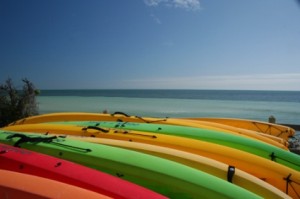Advice for Kayakers and Canoeists
TIME : 2016/2/16 15:56:38

© Laura Martone.
With the weather warming up in the Big Easy, where I’m currently working on the third edition of Moon New Orleans, it’s no wonder that I have boating on the brain. As a follow-up to yesterday’s late-night post about boating safety, I thought I’d focus on two of my other favorite outdoor activities—kayaking and canoeing—both of which can be enjoyed throughout America, from the Everglades to the Colorado River to the Wisconsin Dells. Although some paddling enthusiasts often bring their own vessels with them, you can usually locate an outfitter that rents canoes and/or kayaks for the body of water you hope to explore. In some areas, such as the Florida Keys, many hotels and resorts even offer complimentary canoes or kayaks to their guests.
Paddling along the country’s lakes, rivers, bayous, and coastlines can be a rewarding experience, but it can also be dangerous if you’re ill-prepared. High winds and waves, for instance, can make paddling conditions rather challenging, even for veteran paddlers. In fact, while beginners are welcome to give paddling a try, it’s helpful if you’ve had at least some experience (or instruction) before attempting it alone. No matter what your experience level, however, the following guidelines are necessary for all canoeists and kayakers to remember:
- Ensure that you’ve had proper instruction for the vessel that you plan to use.
- Check the daily weather forecast, especially predicted wind speeds, beforehand.
- Be aware of tidal conditions, currents, and water levels; under normal circumstances, you should allow for a minimum paddling time of two miles per hour.
- Inform someone on shore of your plans, especially your intended destination and expected return time; leave a float plan with a responsible individual, place the plan in a visible spot in your vehicle, and contact the onshore person when you do, in fact, return.
- Arrange to have a vehicle (if not yours) and dry clothes waiting at your take-out point.
- Secure a spare paddle to your vessel.
- Place your keys, identification, money, and other valuables in a waterproof bag and secure the bag to the vessel.
- Apply sunscreen, lip balm, and insect repellent, even on cloudy days.
- Wear appropriate clothing for weather and water conditions.
- Have a readily accessible, personal flotation device (PFD) with attached whistle for each occupant; children under six must wear PFDs at all times.
- Bring plenty of food and drinking water (one gallon per person per day) in non-breakable, watertight containers.
- Bring a cell phone in case of an emergency, but don’t rely solely on the phone, as reception can be sporadic in backcountry and offshore waters.
- Pack up all trash and store it on board until you can dispose of it properly at your trip’s end.
- Leave all historical resources, plants, birds, and marine creatures as you find them.
- Respect all wildlife; do not approach, harass, or feed any birds, marine mammals, or other animals that you see.
- Be considerate of anglers and other paddlers, avoid crossing fishing lines, and stay to the right of motorboats.
- If you’re taking an overnight paddling trip and plan to camp somewhere, be sure to camp on durable surfaces away from the water, and minimize the impact from campfires (if they’re even allowed where you’re staying).
Besides the items already highlighted, you should bring the following essentials with you:
- area maps and NOAA nautical charts
- a compass or GPS
- a bilge pump and sponge
- an anchor (if you plan to snorkel or camp) and some rope
- extra waterproof bags
- a VHF or weather radio to monitor weather forecasts
- signaling devices such as a flashlight, flare, mirror, or airhorn
- a 360-degree light for operating your vessel at night
- sunglasses and a wide-brimmed hat
- a long-sleeved shirt for extra protection
- a first-aid kit
- towels, extra clothing, and extra shoes in a waterproof bag
- binoculars and a camera
- film or batteries
- a pocketknife or multipurpose tool
- duct tape and a repair kit
For more information about canoeing and kayaking in America, consult Paddling.net, Kayak Online, the American Canoe Association, or other helpful online resources—and have fun on your next paddling trip!
